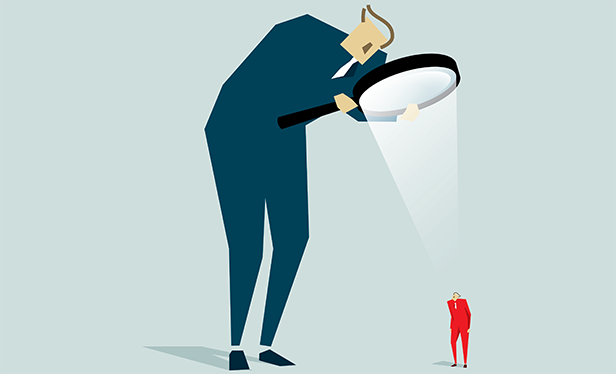A decade after the triple-A failures of the subprime era, gradeinflation is back on Wall Street. This time, Moody's InvestorsService and S&P Global Ratings Inc. are cutting companies slackon mergers and acquisitions, an analysis of credit-ratings data byBloomberg News found.
|Over the past year and a half, both have bumped up their ratingsby two, three or even six levels on a majority of the biggestdeals, the analysis found.
|Moody's and S&P don't dispute those findings, which arebased on ratings guidelines posted on their websites. But the firmssay a by-the-numbers approach overlooks one of their most valuableassets: human judgment. Both make clear that their analysts haveleeway to nudge ratings up or down, based on a company's trackrecord and their confidence in management's commitment to reduceindebtedness.
|“We want our analysts and committees to get behind the story andmake their judgments about what they think the organization willlook like in the next couple of years,” said Mark Puccia, a chiefcredit officer at S&P.
|Said Stephanie Leavitt, a spokeswoman for Moody's: “Theevaluation of financial metrics alone provides an incomplete viewof credit risk to investors.”
|Some investors warn the approach has encouraged an epic debtbinge that could pose dangers as years of near-zero interest ratescome to an end. AT&T's plan to borrow about $40 billion to buyTime Warner Inc., in addition to its $120 billion of debt alreadyoutstanding, is just the latest example.
|In 2015 alone, U.S. companies borrowed a record $1.6 trillion inthe bond markets, with $258 billion of that going to financeacquisitions by investment-grade companies, Barclays says.According to Morgan Stanley, corporate America is now moreleveraged than ever.
|“You have some very large companies that are getting the benefitof the doubt from ratings agencies and from the market,” says JerryCudzil, head of U.S. credit trading for TCW Group, which manages$197 billion in assets. “The longer this goes on, the higher thelikelihood that all of that leads to not only financial losses butto a significant slowdown in the economy and ultimately arecession.”
|Granted, not even die-hard pessimists say rosy ratings are aboutto unleash a full-blown crisis. But it was only a few years agothat Moody's and S&P were criticized for having stampedgilt-edged grades on iffy mortgage investments. Last year, S&Pwas fined $1.5 billion, and Moody's said last week that it faces aU.S. government lawsuit over grades given to securities backed byhome loans.
|Now, by giving some corporations wiggle room to borrow forM&A, Moody's and S&P have helped executives seal deals andborrow vast sums of money.
|Post-crisis legislation required credit-rating companies to bemore transparent about their ratings methodologies. Thosemethodologies are just a starting point, however. If ratingsanalysts are confident an acquirer will pay its debts, the argumentgoes, that confidence should be reflected in the grades. What'smore, investors expect ratings to reflect long-range views, notWall Street's latest whims, the firms say.
|All of which may be fine for bond investors — unless companiesstart to struggle under the weight of this new mountain of debt.“When you start talking about the qualitative factors, you'restepping into an area that's by nature fuzzy,” said ScottMcCleskey, a former Moody's chief compliance officer who testifiedto Congress in 2009 against his former employer, saying Moody'sfailed to properly monitor municipal bond ratings. “You're buildingassumptions on top of assumptions. It's all scientificguessing.”
Human Judgment
How much does human judgment shade corporate ratings? One way toanswer that question is to compare two credit scores — the gradescorporate acquirers would have received based solely on financialmetrics and the ones they actually got.
|Bloomberg examined U.S. deals with values of at least $10billion, excluding financial firms and utilities, that wereannounced in the 18 months ended June 30 and funded with debt.
|Both Moody's and S&P rated 32 such transactions. At Moody's,27 of the ratings were higher than the ones the firm typicallyassigns to companies with comparable debt loads. At S&P, 17 outof 32 of the acquiring companies got higher ratings.
|In Moody's case, no company received a rating that was lowerthan the metrics suggested. In other words, Moody's bumped manyratings up, but none down.
|S&P assigned lower ratings to four of the companies.
|“Sometimes the ratings agencies give companies the benefit ofthe doubt that they can achieve the debt reduction that the companyhas articulated,” said Joel Levington, a former S&P directorand now head of credit research for Bloomberg Intelligence.
|While neither Moody's nor S&P took issue with those numbers,both emphasized they're upfront about how their analysts exercisejudgment.
|Moody's says its ratings reflect dozens of factors, ranging froma company's size to its brand strength to its willingness toinnovate, as well as familiar financial measures such as itsleverage ratio. It makes plain that “forward-looking expectations”can influence ratings.
|Moody's analysts often assign ratings that differ from what itshard metrics might indicate, according to Mariarosa Verde, a seniorcredit officer. “The committee uses its own judgment,” shesaid.
Repay Debt
S&P evaluates a company's ability to repay debt, referred toas financial risk. It compares that with the company's businessrisk, which factors in things like the company's profitabilityand how competitive it is relative to peers. Where the two riskfactors intersect on a matrix determines the rating, according toS&P's website.
|In its analysis of S&P, Bloomberg used the business-risklabels that S&P established and plotted it against S&P'sbenchmark for financial risk. Bloomberg found that in more thanhalf the deals, the companies had gotten ratings that didn't lineup with the matrix.
|In looking at M&A, S&P says it encourages its analyststo take stock of management's credibility, the reasons for doing adeal and the company's record with acquisitions, as well as itsplans for structuring and financing the combined companies.According to its website, S&P's methodology allows forcommittees to assign ratings that are one level above or below whatthe guidelines suggest.
|With some recent M&A deals, however, the firms stretchedfurther. Here are examples:
- Dell Inc.'s debt relative to earnings after the Septemberpurchase of EMC Corp. warranted a rating as low as the Caa band,one of the lowest rungs of speculative grade, from Moody's, theBloomberg analysis found. Moody's rated the company Ba1, sixnotches higher.
- Charter Communications Inc. received a BB+ grade from S&Pafter it announced its purchase of Time Warner Cable Inc. UsingS&P's estimate of the company's future leverage levels and itsview of the company's business risk, and taking into accountCharter's $60 billion of debt, the rating should have been BB-, twonotches lower, according to Bloomberg's analysis. In 2009, Charterwent into bankruptcy under the weight of $21 billion in debt.
- Newell Brands Inc., maker of Rubbermaid, deserved a junk gradebetween B and Ba from Moody's after it agreed to buy Jarden Corp.,based on a leverage ratio that was about double its peers withsimilar ratings, the analysis found. Moody's gave it aninvestment-grade Baa3.
- Kraft Heinz Foods Inc.'s leverage ratio and S&P'sassessment of management justified a downgrade to as low as BB-, ajunk rating, the analysis found. S&P gave it an investmentgrade of BBB-, three notches higher.
- In June, S&P blessed Microsoft Corp.'s $26 billion purchaseof LinkedIn Corp. with its highest rating. It cited Microsoft's“long history of making investment decisions in a fiscally prudentmanner” — even though Microsoft had just written down nearly thefull $9.5 billion value of its 2014 purchase of Nokia Corp.'smobile-phone unit.
Ratings officials say that deals that hurt a company's credithealth don't always result in downgrades if analysts believe theimpact will be temporary.
|“If you have a seasoned management team that's done this before,it's a different consideration than if you have new managers withno track record,” Verde of Moody's says.
|Taking Issue
In some instances, Wall Street analysts have taken issue withthe ratings firms. For instance, not everyone thought Moody's andS&P went far enough when they downgraded Teva PharmaceuticalsIndustries Ltd. by one notch after the drug company agreed to buyAllergan Plc earlier this year for $40.5 billion.
|“The rating agencies have gone easy on the company,” CarolLevenson, an analyst at GimmeCredit, wrote in a July report.
|While drug companies like Teva typically generate enough cash topay their debts, the ratings companies were taking a leap inconcluding that Teva's management would refrain from acquisitionsin the future, she said.
|“Where faith comes into the picture is believing that managementwill choose to use every penny of free cash flow to reduce debt,”Levenson wrote.
|Most people agree that credit ratings are part art and partscience. S&P analysts often give high-rated companies morelatitude in deal making than low-rated ones,since high-ratedcompanies are supposed to be financially stronger to begin with,according to its methodology.
|But back in 2008, when the last crisis struck, some companiesthat received investment grades from Moody's defaulted morefrequently than those at the high end of the junk-bond market. Thesame thing happened with S&P in 2009. The ratings companies, inother words, had underestimated the risks.
|This time around, some bondholders have already lost money, atleast on paper.
|Like many on Wall Street, Moody's misread ValeantPharmaceuticals International Inc., which has seen rocky timesfollowing a series of debt-fueled takeovers. Moody's maintained itsratings as the company's debt ballooned, citing Valeant's“successful acquisition track record.” Over the past year,investors who hold Valeant's most actively traded bond have lostabout 8%, according to data compiled by Bloomberg.
|Likewise, Perrigo Co. received higher credit scores becauseS&P said it trusted management to reduce the genericdrugmaker's indebtedness, even after Chief Executive Officer JosephPapa increased it with another acquisition. Last year, Perrigobonds were the second-worst performing of investment-grade healthcare companies with dollar-denominated debt in the Bank of AmericaMerrill Lynch U.S. Healthcare Index.
|“There has to be judgment to give real value to ratings,” saidAdam Zurofsky, a former senior adviser at S&P, who was speakinggenerally and not about any specific deals. “But that judgment hasto be exercised responsibly.”
|Said David Horsfall, deputy chief investment officer at StandishMellon Asset Management Co. in Boston: “This all works until themarket says, 'No thank you, that's too much debt.' ”
|Regulators need to keep a close eye on the credit-ratingcompanies, said U.S. Senator Al Franken, a Minnesota Democrat. “Thepractice of routinely raising ratings based on subjective factorscertainly deserves scrutiny.”
|Bloomberg News
|Copyright 2018 Bloomberg. All rightsreserved. This material may not be published, broadcast, rewritten,or redistributed.
Complete your profile to continue reading and get FREE access to Treasury & Risk, part of your ALM digital membership.
Your access to unlimited Treasury & Risk content isn’t changing.
Once you are an ALM digital member, you’ll receive:
- Critical Treasury & Risk information including in-depth analysis of treasury and finance best practices, case studies with corporate innovators, informative newsletters, educational webcasts and videos, and resources from industry leaders.
- Exclusive discounts on ALM and Treasury & Risk events.
- Access to other award-winning ALM websites including PropertyCasualty360.com and Law.com.
*May exclude premium content
Already have an account? Sign In
© 2024 ALM Global, LLC, All Rights Reserved. Request academic re-use from www.copyright.com. All other uses, submit a request to [email protected]. For more information visit Asset & Logo Licensing.







